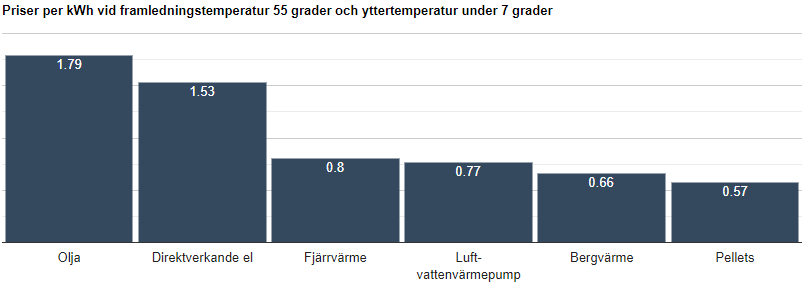Heating with pellets - frequently asked questions
What is pellets heating?
Wood pellets is a cylindrical biofuel made from sawdust, wood chips and other residual products from the wood and forest industry. Pellets heating is very popular as an energy source for heating single-family homes, industrial premises and agricultural properties.
The benefits of pellets are many. To begin with, pellet heating is cheaper than many other heat sources, such as oil and electricity. Furthermore, pellet heating has a clear advantage from an environmental point of view as it is a renewable energy source. Thanks to automated feeding, a pellet boiler or burner requires very little supervision compared to, for example, a wood boiler.
So-called pellet stoves are also a popular and cost-effective alternative to air source heat pumps.
What do pellets cost?
The average price for high-quality pellets in Sweden is between 2.50-3 SEK / kg (or 2,500-3,000 SEK per ton), depending on how much you buy per occasion. Wood pellet is sold in bulk, large sacks and small sacks on pallets (usually 52 x 16 kilos). When it comes to high quality pellets they must have a high energy content (around 5 kWh per kilo), good strength, low ash and moisture content and a high ash melting temperature.
Start with the amount of pellets you need, and how much will fit in your pellet storage. High quality pellets usually do not get old, as long as they are stored correctly. In Sweden, the standard sizes for pellets are 6 mm and 8 mm. Some pellet burners are adapted for the smaller size, but for most burners and boilers, the size of the pellets has no significance for operation and power.
Is wood pellet a cheap energy source?
Pellet heating is a cheap alternative to oil and electricity for heating houses. For example, if you buy pellets in large volumes, you can reduce the kWh price to between 0,50 and 0,70 SEK / kWh, including VAT and delivery in Sweden. This can be compared with oil, which is currently around SEK 1.8 / kWh and electricity, which fluctuates from SEK 1.50 to SEK 2.50 / kWh with electricity transmission fee and energy tax.
Villas with basements and radiators are also not adapted for heat pumps because they work with lower supply temperatures. With a flow temperature of 55 ° C and an outside temperature of -7 ° C, pellet heating is cheaper than both geothermal heating and air and water heat pumps. In other words, installing a pellet boiler in your house is an investment that pays for itself quickly. To maximize the efficiency of your pellet plant, also consider using a wireless shunt automation. Read our guide on how the ESBE CRB221 can improve heat regulation and lower your heating costs. Learn more about how supply and outside temperatures affect your kWh price in our price calculator (in Swedish).

How much wood pellets is needed to heat my house?
For a normal-sized house, you need approximately 5-7 tons of pellets (which corresponds to 9-10 m3) to cover a year's consumption of 25,000-30,000 kWh. Out of these kilowatt hours, 20,000 kWh is used to heat the house, 5,000 kWh is used for hot water and the other kWh constitutes average consumption of electricity (lighting, white goods and consumer electronics, etc.).
You can also choose to use pellets as a complement to other energy sources. For example, by installing a pellet stove indoors that automatically regulates and keeps the internal temperature at a comfortable level. In addition to reduced electricity costs, a pellet stove also contributes to a dramatically increased cosiness factor.
What does it cost to install a pellet stove?
Ulma's pellet stoves are available in a variety of designs and prices - from just over 14,000 to just over 33,000. In addition to the cost of the stove itself, there is also a cost for assembly and installation of between 10-15,000 SEK (before ROT deductions) in Sweden. If you do not have a chimney where you intend to place your pellet stove, you should also expect additional costs for this.
It is not uncommon for companies that build and seal chimneys to also install stoves. By agreeing on a package price, you can usually get down in price.
Do I need a special burner to be able to fire with pellets?
To fire with pellets, you need a boiler and a pellet burner. Do you already have a working oil or wood boiler in your home? Then in most cases you can only mount on a pellet burner from Ulma. Our Swedish-made pellet burners have a high efficiency and light up quickly and smoothly thanks to a hot air element, specially developed by us.
If you do not have a pellet stove, you can use a pellet basket and fire with pellets in your regular wood-burning stove.
Is wood pellets an environmentally friendly heating source?
Pellets are a renewable, environmentally safe and environmentally conscious choice of energy source. To begin with, pellets are a by-product of the wood industry. This means that it does not add new carbon dioxide to the atmosphere during combustion. Compared to fossil fuels such as oil, gas and non-renewable electricity, pellets are a relatively climate-smart method of heating their property.
The biggest climate threat when it comes to pellet heating is old, outdated boilers. By mounting an ackumulator tank on an old boiler, you can reduce carbon dioxide and methane emissions by as much as 90%.
Does a pellet boiler need a lot of supervision and maintenance?
A new pellet boiler requires very little maintenance. Unlike a wood boiler, the pellets are fed in automatically. In addition, quality pellets leave behind much less soot and ash than, for example, wood and cheap pellets. This in turn means that it is enough to clean out your forehead once a month.
If you use cheap pellets, however, you should expect to have to look at your pellet burner more often. This is because cheap pellets, in addition to leaving more soot and ash behind, also have a tendency to crumble, which can lead to stoppages in the feed.
In addition to this, it only remains to replenish the pellet stock a few times a year, depending on what storage you use.
How should I store my pellets?
Pellets should be stored cool and dry, preferably in a pellet storage intended for the purpose. How much space you can spare for your pellets differs from house to house, but we recommend at least 6-7 m2. If you are prepared to refill pellets often, it is possible to reduce the storage areas considerably. However, this is not optimal if you have planned to be away for more than a week in a row. At Ulma, we can offer accessories for all types of pellet storage – from small indoor solutions to large bulk storage.
When it comes to automated feeding, it is important to check that your pellets do not "settle". The fact that the pellet stock has settled can cause so-called arches, which means that the feed screw does not pick up new pellets and fuel faults occur.
What do I do with the ash from my boiler or pellet stove?
After firing, the ashes that remain should be stored in a non-combustible container (of, for example, stone, ceramic, or metal) fitted with a lid. To be sure that the ash does not contain embers, you should wait at least three to four days before disposing of it.
Pellet ash is strongly alkaline (ie has a high pH value), which are good properties for reducing acidification in forests and soil. Spread the ashes in nature, either in the forest or in your garden, for example in the flower bed or on the plot. However, no more than 1 liter of ash per m2 of lawn.
Ash from pellet burners and pellet stoves can contain small amounts of heavy metals, making it unsuitable for spreading on vegetable plantations, fruit trees and under berry bushes.
